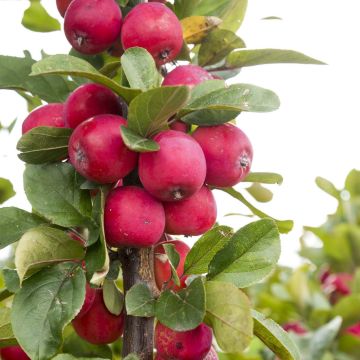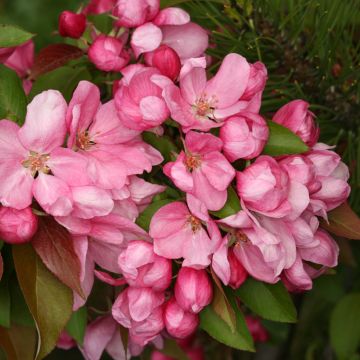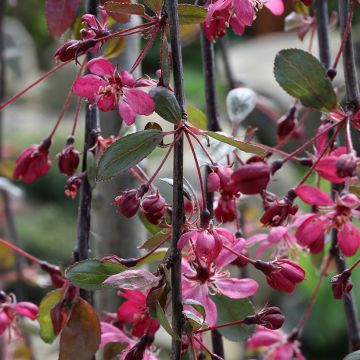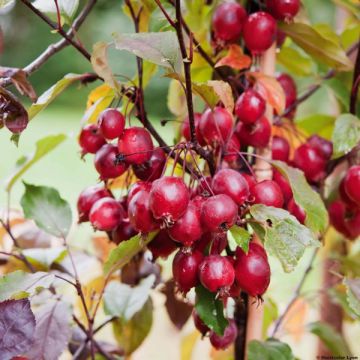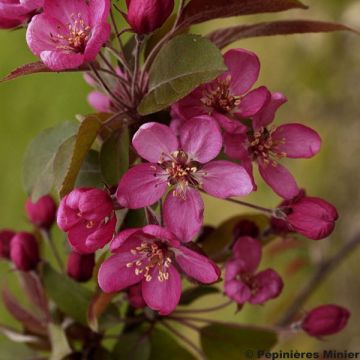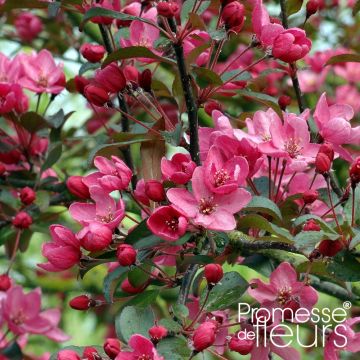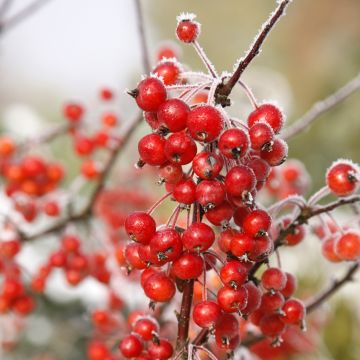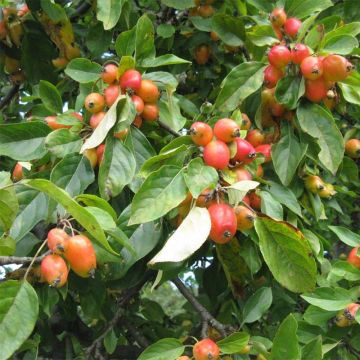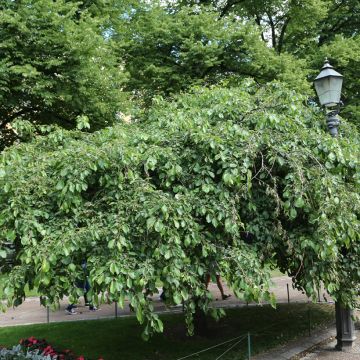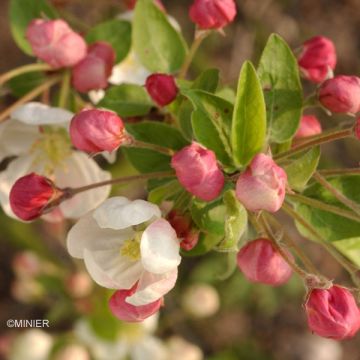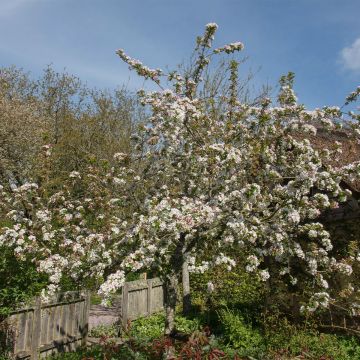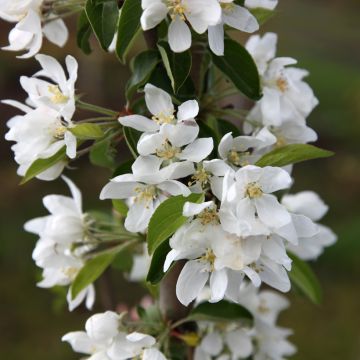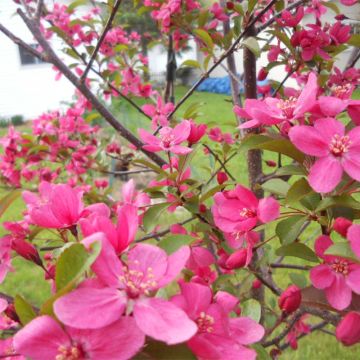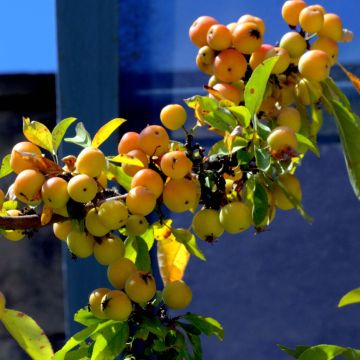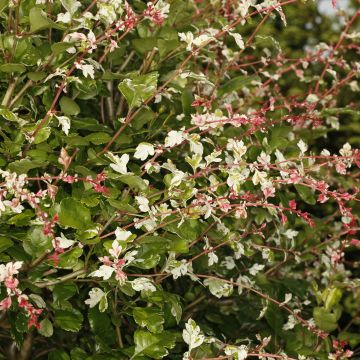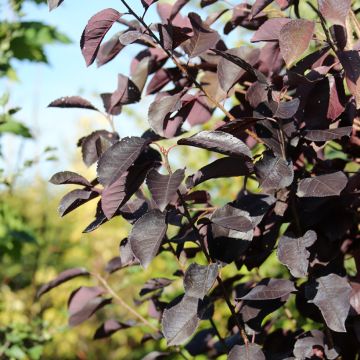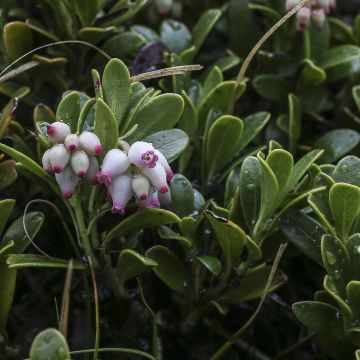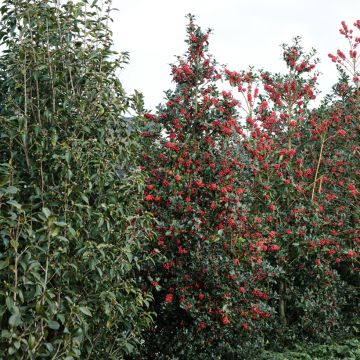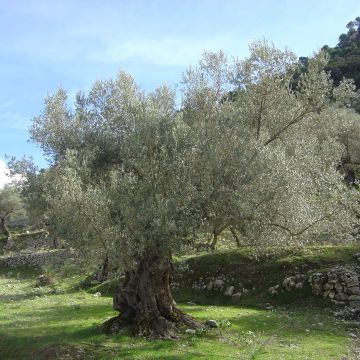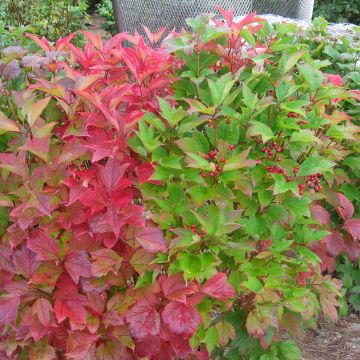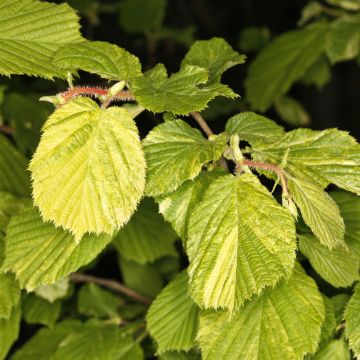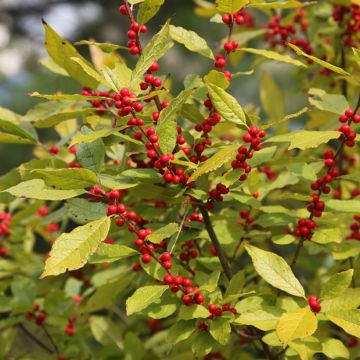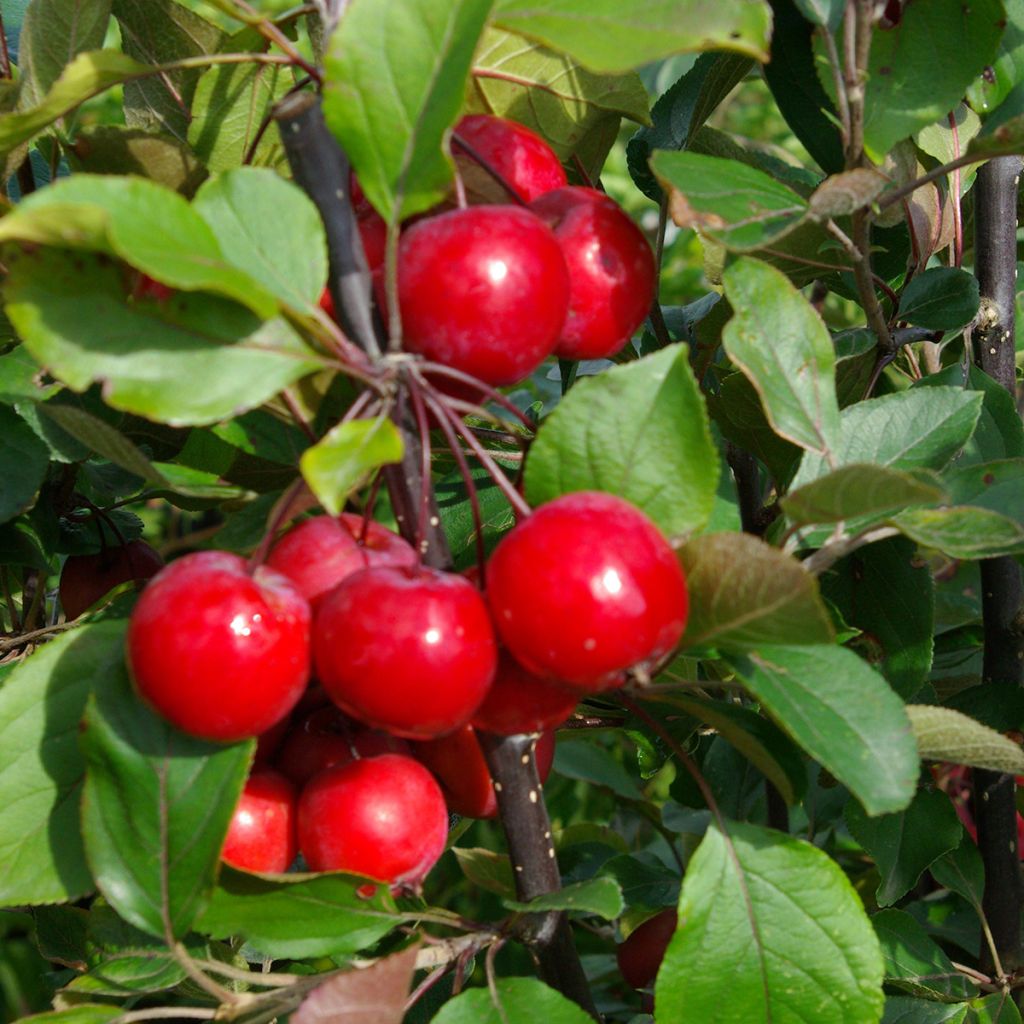

Malus purpurea Neville Copeman - Purple Crab Apple
Malus purpurea Neville Copeman - Purple Crab Apple
Malus x purpurea 'Neville Copeman'
Crab Apple
Why not try an alternative variety in stock?
View all →This plant carries a 24 months recovery warranty
More information
We guarantee the quality of our plants for a full growing cycle, and will replace at our expense any plant that fails to recover under normal climatic and planting conditions.
From €5.90 for pickup delivery and €6.90 for home delivery
Express home delivery from €8.90.
Does this plant fit my garden?
Set up your Plantfit profile →
Description
Malus 'Neville Copeman' is a quite spectacular selection of ornamental apple tree, first because of its abundant spring flowering in purple-pink, but also because of its beautiful foliage that retains a copper to purple blush in summer and remarkable fruits, large and well-coloured when ripe. It is a wide and bushy apple tree that stands out in the garden, even in winter. Useful for bees and birds, this small tree also serves as a good pollinator for fruit-bearing apple trees. Its only flaw is a poor resistance to scab.
Ornamental apple trees come from various botanical species of the genus Malus belonging to the rose family. Hardy, accommodating, and easy to grow, Flowering Apples are content with ordinary soil, but prefer loamy, deep, loose, and moist soil and sunny exposures. Once established, they tolerate being forgotten while maintaining their generous character. Many cultivars have emerged in Europe, as well as in the United States, becoming increasingly attractive and disease-resistant. 'Neville Copeman' came from a seedling of Malus x purpurea 'Eleyi'.
Malus 'Neville Copeman' is a small tree that develops a wide, semi-open, well-branched crown, almost as wide as it is tall, often asymmetrical. Its average dimensions at maturity are about 6m high and 5m in spread. It develops wood covered with smooth dark reddish-brown bark. The abundant flowering takes place in May, earlier or later depending on the region, on branches which are still bare or barely covered with very young purple leaves. It takes the form of numerous, very dark pink buds that quickly open into single flowers, 3-4 cm in diameter. Their colour is a lilac pink tending towards purple, becoming duller and darker before fading. These flowers, gathered in small clusters, are followed by young leaves. The flowers are loved by bees and followed by the formation of many fruits measuring between 3 and 4 cm in diameter. When ripe, in September-October, their reddish-orange background becomes tinged with violet and they are covered with a wax that gives them a light red to pinkish colour. These beautiful little apples remain on the branches for a long time if not eaten by birds. The deciduous foliage turns green as it unfolds, while always retaining a slightly coppery to plum colour, even in summer. It becomes yellow-orange in autumn before falling. The leaves are ovate, alternate, and toothed.
Malus 'Neville Copeman' is suitable for medium-sized gardens and large plots. Its charming flowering may be less long-lasting than that of a flowering cherry tree, but it is prolonged by the undeniable beauty of its fruits. You can easily associate it with spring-flowering shrubs. It will also accompany large shrub roses, lilacs, or even hawthorns. When space is available, ornamental apple trees, planted in a large hedge on a slope bordering a sunken path, create a rather magical scene in spring, as well as in autumn, as their colours are often magnificent at the end of the season.
Report an error about the product description
Plant habit
Flowering
Foliage
Botanical data
Malus
x purpurea
'Neville Copeman'
Rosaceae
Crab Apple
Malus x purpurea 'Neville Copeman'
Cultivar or hybrid
Other Malus - Crabapple
Planting and care
Malus 'Neville Copeman' is easy to grow on ordinary, deep soil and requires a bright and sunny exposure to flower well. Ornamental apple trees are generally very accommodating, but they like fertile, loose, moist soil that is not too dry. After careful planting and regular watering during the first two years, they manage on their own. Plant it in the sun or partial shade, giving it room to spread. Dig a large planting hole. If the soil is poor, add compost or topsoil to the planting soil and apply fertiliser or compost to its base every spring. To prevent diseases, treat with Bordeaux mixture in spring.
Planting period
Intended location
Care
This item has not been reviewed yet - be the first to leave a review about it.
Ornamental fruit shrubs
Haven't found what you were looking for?
Hardiness is the lowest winter temperature a plant can endure without suffering serious damage or even dying. However, hardiness is affected by location (a sheltered area, such as a patio), protection (winter cover) and soil type (hardiness is improved by well-drained soil).

Photo Sharing Terms & Conditions
In order to encourage gardeners to interact and share their experiences, Promesse de fleurs offers various media enabling content to be uploaded onto its Site - in particular via the ‘Photo sharing’ module.
The User agrees to refrain from:
- Posting any content that is illegal, prejudicial, insulting, racist, inciteful to hatred, revisionist, contrary to public decency, that infringes on privacy or on the privacy rights of third parties, in particular the publicity rights of persons and goods, intellectual property rights, or the right to privacy.
- Submitting content on behalf of a third party;
- Impersonate the identity of a third party and/or publish any personal information about a third party;
In general, the User undertakes to refrain from any unethical behaviour.
All Content (in particular text, comments, files, images, photos, videos, creative works, etc.), which may be subject to property or intellectual property rights, image or other private rights, shall remain the property of the User, subject to the limited rights granted by the terms of the licence granted by Promesse de fleurs as stated below. Users are at liberty to publish or not to publish such Content on the Site, notably via the ‘Photo Sharing’ facility, and accept that this Content shall be made public and freely accessible, notably on the Internet.
Users further acknowledge, undertake to have ,and guarantee that they hold all necessary rights and permissions to publish such material on the Site, in particular with regard to the legislation in force pertaining to any privacy, property, intellectual property, image, or contractual rights, or rights of any other nature. By publishing such Content on the Site, Users acknowledge accepting full liability as publishers of the Content within the meaning of the law, and grant Promesse de fleurs, free of charge, an inclusive, worldwide licence for the said Content for the entire duration of its publication, including all reproduction, representation, up/downloading, displaying, performing, transmission, and storage rights.
Users also grant permission for their name to be linked to the Content and accept that this link may not always be made available.
By engaging in posting material, Users consent to their Content becoming automatically accessible on the Internet, in particular on other sites and/or blogs and/or web pages of the Promesse de fleurs site, including in particular social pages and the Promesse de fleurs catalogue.
Users may secure the removal of entrusted content free of charge by issuing a simple request via our contact form.
The flowering period indicated on our website applies to countries and regions located in USDA zone 8 (France, the United Kingdom, Ireland, the Netherlands, etc.)
It will vary according to where you live:
- In zones 9 to 10 (Italy, Spain, Greece, etc.), flowering will occur about 2 to 4 weeks earlier.
- In zones 6 to 7 (Germany, Poland, Slovenia, and lower mountainous regions), flowering will be delayed by 2 to 3 weeks.
- In zone 5 (Central Europe, Scandinavia), blooming will be delayed by 3 to 5 weeks.
In temperate climates, pruning of spring-flowering shrubs (forsythia, spireas, etc.) should be done just after flowering.
Pruning of summer-flowering shrubs (Indian Lilac, Perovskia, etc.) can be done in winter or spring.
In cold regions as well as with frost-sensitive plants, avoid pruning too early when severe frosts may still occur.
The planting period indicated on our website applies to countries and regions located in USDA zone 8 (France, United Kingdom, Ireland, Netherlands).
It will vary according to where you live:
- In Mediterranean zones (Marseille, Madrid, Milan, etc.), autumn and winter are the best planting periods.
- In continental zones (Strasbourg, Munich, Vienna, etc.), delay planting by 2 to 3 weeks in spring and bring it forward by 2 to 4 weeks in autumn.
- In mountainous regions (the Alps, Pyrenees, Carpathians, etc.), it is best to plant in late spring (May-June) or late summer (August-September).
The harvesting period indicated on our website applies to countries and regions in USDA zone 8 (France, England, Ireland, the Netherlands).
In colder areas (Scandinavia, Poland, Austria...) fruit and vegetable harvests are likely to be delayed by 3-4 weeks.
In warmer areas (Italy, Spain, Greece, etc.), harvesting will probably take place earlier, depending on weather conditions.
The sowing periods indicated on our website apply to countries and regions within USDA Zone 8 (France, UK, Ireland, Netherlands).
In colder areas (Scandinavia, Poland, Austria...), delay any outdoor sowing by 3-4 weeks, or sow under glass.
In warmer climes (Italy, Spain, Greece, etc.), bring outdoor sowing forward by a few weeks.

































